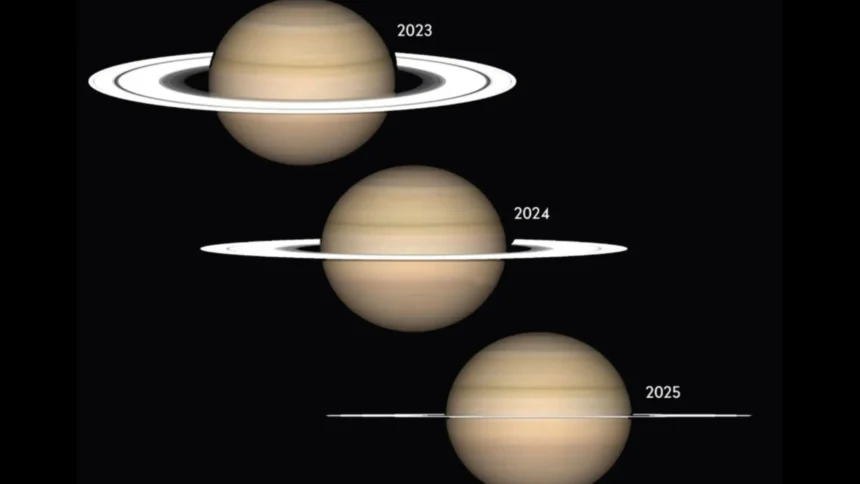Saturn’s eye-catching rings will look almost invisible from our view on Earth in March 2025. This happens because of a trick optic thingy, and because Saturn is leaning on its axis. Since Saturn goes around the Sun every 29.5 years, every few years, the edge of its rings go straight into our eyesight line.
The rings are very thin, barely tens of meters thick in most cases, and they reflect a small amount of light when seen edge-on.
This makes them like they’re invisible. Also, Saturn has its side tilted at 26.7 degrees, which makes it seem as if the rings vanish from the perspective on Earth.
What Happens During the Edge-On View?
Saturn’s rings shine bright by reflecting sunlight, and they show off a beautiful appearance at particular viewing positions.
But, when the angle of the rings is straight on, like it will be on March 23, 2025, they seem to disappear.
This is because their material is very thin; the majority of it is only a few tens of meters thick. This thing can be thought of like when you hold a piece of paper straight up; when you look at it from the side, the paper looks almost like it’s not there, because it reflects very little light.
Previous Occurrences of Ring Disappearance
The recent 2009 and 1995 times when Saturn’s rings looked edge-way were notable. In these periods, scientists took important observational data and pictures that showed how the rings were uniquely aligned.
In 2009 the planet’s rings got hard to see, but telescopes like the Hubble Space Telescope showed amazing pictures that show how thin the rings are. In 1995 Scientists noticed something important when the rings lay flat on our line of sight.
This gave them a chance to look at how the rings move and what they are made of, which isn’t easy to do when they are wide in front of us.
These insights helped us learn more about Saturn’s ring system and showed how unusual these alignments are in its orbit journey.
The Return of the Rings
After they became almost invisible on March 23, 2025, as Saturn’s rings appear edge-on to us, they will slowly be seen again through telescopes in the next few months.
Jonti Horner, an astrophysicist at the University of Southern Queensland says, “They’ll gradually return to view through big telescopes before leaving sight again in November 2025.
By 2032, the rings of Saturn will be 27 degrees turned away from Earth, showing their lowest part at the best viewing time.
Small telescopes may see the rings clearly when they turn more and shine brighter, probably around late 2025 or early 2026. The rings will keep showing up until 2038 and 2039.
Scientific Implications of the Disappearance
The edge-on look of Saturn’s rings offers a rare chance for study. Scientists can learn about the structure and movement of the rings like never before during this time.
When the rings appear from this side, they make long shadows that show parts usually hidden when seen from other points.
This thing can offer ideas about how rings are made and change, which help us know about the overall creation of planets.
The rings act as a live example of what happened when the whole solar system began, showing us how solid bits join together and grow.
New research shows that the rings around Saturn could be quite young, possibly made from pieces of a bigger moon. This tells us a lot about how planets and systems grow up.
Cultural and Historical Significance of Saturn’s Rings
Saturn has deeply affected arts, stories, and old tales, mainly through its connection with the Roman deity Saturn, similar to the Greek mythical Titan Cronus. In Roman lore, Saturn was thought of as a kind and generous king during a legendary Golden Age. This time stood for playfulness and tranquility.
This image of Saturn influenced many kinds of art and books, leading to pictures of peaceful countryside and themes about wealth.
The celebration of Saturnalia in December also spread this image, creating a culture filled with fun and equality that affected all parts of Roman society. More so, Saturn’s bright rings have fascinated space scientists and artists, making them important in promoting the study of astronomy.
These rings which Galileo observed in 1610 are now directly linked to saturn more than anything. They inspire many concepts in art and numerous questions in science and stitch together the full range of tales from the mouths of mythology to the advanced science of today.
As the worldwide observation of the rings approaches the year 2025, people wait with hope not only for the aesthetic treat but also for the scientific information as well which this project may offer.
This special chance of opportunity is a good break for novices and expert stargazers who have an opportunity to learn more about our solar system and in the process understand more the mechanisms behind the movement of the planets and what composes the stars and the planets.


Leave a Reply